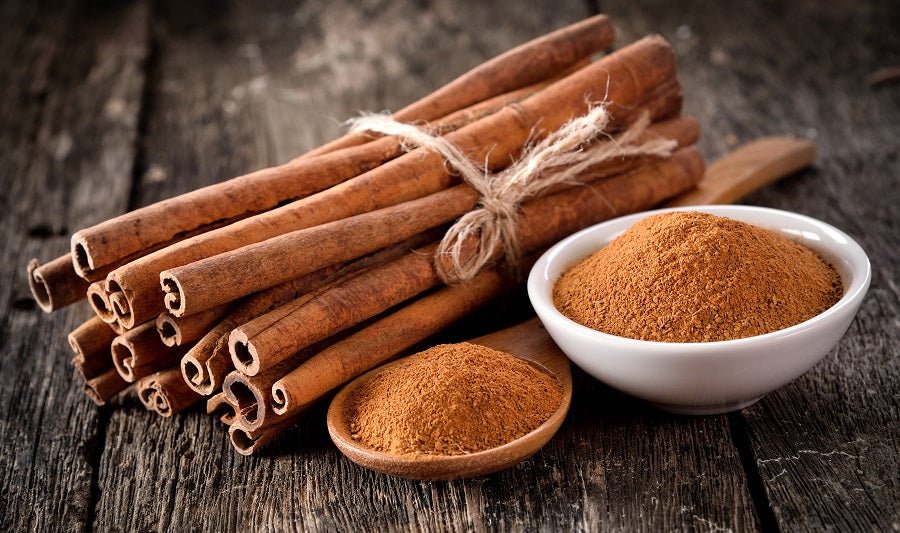The Spice With A History
Cinnamon: A spice that is found in every indian household and often used in curries and baking. Well, there is no denying that we love cinnamon in our breads and buns, cookies and cakes, pies and puddings. It is safe to even say that it’s the reigning spice of all things sweet, especially when autumn comes by. But what exactly is cinnamon? Cinnamon is a spice made from the bark of species of the cinnamon tree. It can be bought in its reddish-brown ground form (cinnamon powder) or in the form of curled sticks – cinnamon sticks. Cinnamon has been used as a spice for thousands of years, even utilized in ancient Egypt. It was brought to these areas via land and sea spice routes from India and China, but the sources were kept secret by Arab spice traders. Let’s learn more about this spice with a history worth re-telling!
Are there different types of cinnamon available?

Yes, there are two types of cinnamon that are commonly available in the market – Cassia Cinnamon & Ceylon Cinnamon. Cassia cinnamon (Cinnamomum cassia) is typically imported from China, Vietnam, India and Indonesia, and is the most typical type of cinnamon available worldwide. Cassia owes its deep reddish-brown color to the cinnamon tree, from which one piece of hard bark is harvested, and then rolled or ground. Cassia’s flavor is spicy and sweet with a mild scent. Ceylon cinnamon (Cinnamomum verum), imported from Sri Lanka and Madagascar, is more commonly used in Europe and Mexico. This type of cinnamon has a sweet, almost-floral aroma. Ceylon sticks are created by rolling several layers of delicate bark from the interior of a cinnamon tree, resulting in a light-brown color
What’s The Difference Between Cinnamon Powder & Cinnamon Sticks?

Ground cinnamon is cinnamon bark that has been ground to a powder form, whereas cinnamon sticks consist of the same bark rolled up into quills, so the one of the visible big differences is the form. Hence, you can use the two different forms of cinnamon in different ways. You can sprinkle ground cinnamon while you add cinnamon sticks to a liquid so that it can infuse into that liquid. In both cases, the results will be similar enough but cinnamon sticks generally offer a rather subtle flavor when compared to powdered cinnamon. Both cinnamon powder and cinnamon sticks have a longer shelf life when you store them properly. However, cinnamon sticks usually tend to last longer. In general, ground spices have a much shorter shelf life compared to whole spices. Cinnamon powder lasts for about six months under ideal conditions whereas whole cinnamon sticks can last for up to two years.
You may use ground cinnamon in any application that calls for a cinnamon stick. In a dish that consists mostly of liquid or a beverage, you may need to add it later in the cooking or baking process. Adding it while cooking to the liquid results in releasing its flavor more quickly and the flavour might not last longer. Hence, adding it closer to the end of cooking can ensure that it is still flavorful when served. You can use cinnamon sticks in place of ground cinnamon without changing anything if the application contains a lot of liquid. In these cases, you can simply steep the stick and take it out before serving. In a dry application, cinnamon powder is the best pick over a cinnamon stick.
What Are The Benefits Of Cinnamon Powder?

Cinnamon is a spice that is made from the inner bark of trees scientifically known as Cinnamomum. It has been used as an ingredient for time immemorial. The usage of cinnamon dates back to Ancient Egypt. Cinnamon contains high levels of cinnamaldehyde which makes it a spice filled with health benefits. The bark of the cinnamon tree is powdered and used as cinnamon powder. Cinnamon powder is loaded with health benefits that help improve one’s immunity & overall health. Rich in antioxidants, cinnamon also has anti-inflammatory effects, which help lower your risk of disease and keep radicals at bay. It also helps in regulating key risk factors for heart disease, such as cholesterol, triglycerides and blood pressure. It also helps in regulating diabetes & consuming one teaspoon of honey with cinnamon powder is proven to be beneficial. Cinnamon powder is used in baking, cooking and also for skin and hair care.
Can One Make Cinnamon Powder At Home?

Yes! It is rather simple to make homemade cinnamon powder if you want to experiment a little. Here’s a recipe that could help you out:
Ingredients
- 1 cup broken cinnamon sticks
- 1 tbsp brown sugar
Steps
- Roast the whole cinnamon and then crush it into a fine powder. While grinding add 1 tbsp of brown sugar (1:1 ratio).
- Dry roast the cinnamon sticks in a pan for 2 minutes on low flame.Switch off the flame and transfer roasted cinnamon to a big plate. Let it cool completely. Now grind roasted cinnamon sticks with 1 tbsp of brown sugar.
How to store?
- Store in an airtight jar in a cool, dry place. You can make it in bulk. A small amount of it can be stored in a bottle for daily use and the rest can be kept in a refrigerator.
It is best used within three months.
Tip: If you want very fine powder. Sieve the mixture. You can also grind cinnamon without sugar. Sugar is added because it creates friction to grind cinnamon into a fine powder.
